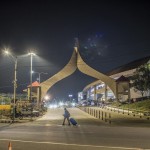Reported by
Children fleeing violence and extreme hardship in their home countries are facing “alarming levels of violence, family separation, and uncertainty” while migrating through Mexico's border cities, according to a new report released Monday.
The study, published by Save the Children and Plan International, is based on 155 interviews conducted between November 2024 and February 2025 with migrant children ages 7 to 16 and their caregivers. The research focused on three key migration hubs: Ciudad Juárez, Reynosa, and Tijuana.
Most of the children interviewed were from Mexico, Honduras, Venezuela, Colombia, and Guatemala, though some came from as far as Afghanistan and Haiti.
The reasons for migration varied, with 34.8 percent of children saying they migrated to reunite with their families. Another 21.3 percent fled due to criminal violence, while 11.6 percent cited direct threats or community conflict.
The number of unaccompanied child migrants traveling through Mexico has nearly doubled in five years, rising from 69,500 in 2019 to more than 137,000 in 2023. This increase has been fueled by growing insecurity, poverty, and climate-related displacement across Latin America and beyond.
While many children begin their journeys with a parent or guardian, family separation is common. In Ciudad Juárez, nearly two thirds or 63.5 percent of children said they left home accompanied, “but only about one third arrived in Mexico with someone by their side.”
Unaccompanied children—especially girls—are particularly vulnerable to sexual and gender-based violence, exploitation, trafficking, and forced recruitment by armed groups. Their hardships often continue even after reaching Mexico’s northern border, where many are forced to live for months in overcrowded shelters with restricted movement due to fears of kidnapping.
During the journey to the northern border, unaccompanied children are extremely vulnerable and often become prime targets for organized crime groups, according to the report.
Tightened Mexican immigration policies and increased militarization of the border have pushed many families onto irregular, high-risk routes dominated by criminal networks. These routes are known for trafficking, express kidnappings, and other violent crimes.
“Organized crime has many ways of finding and grabbing you. There are many areas where it’s hard to run away if you’re trying to escape,” said a 16-year-old unaccompanied boy interviewed in the report.
“No child should find themselves in this situation, especially after enduring such a perilous journey to find safety,” said Reena Ghelani, CEO of Plan International.
“They need support now – including protection, access to safe shelter, education and mental health care. We are seeing families so desperate that children are being forced to consider returning to the very places they fled from. That should never be their only option,” she stressed.
The findings echo a 2023 United Nations warning of a growing “child migration crisis” in Latin America and the Caribbean. In the first eight months of that year, more than 60,000 children—half under age five—crossed the treacherous Darién Gap between Colombia and Panama, marking the highest number of child migrants to ever traverse the region in a single year.






